The satellite internet battlefield has a new contender. After years of development, Amazon Leo (formerly Project Kuiper) has officially launched its enterprise preview in November 2025, bringing Elon Musk’s Starlink face-to-face with Jeff Bezos’ ambitious constellation. With over 150 satellites already in orbit and plans to deploy 3,236 low-Earth orbit (LEO) satellites, Amazon Leo represents far more than a commercial rivalry—it’s a pivotal moment for India’s digital future, regulatory framework, and strategic autonomy in space.
For India, this competition offers unprecedented opportunities to bridge the digital divide in remote areas, yet simultaneously poses complex regulatory, security, and geopolitical challenges. This blog examines what Amazon Leo means for India’s connectivity ambitions, space policy, and the critical choices policymakers must navigate in the coming years.
Key Highlights:
- Amazon Leo vs Starlink Competition: Amazon Leo delivers up to 1 Gbps download speeds and 400 Mbps uploads via the Leo Ultra terminal, directly challenging Starlink’s proven network across 100+ countries.
- Global Space Economy Boom: The LEO broadband sector is emerging as a $40 billion opportunity by 2030, reshaping how the world approaches rural connectivity and critical infrastructure.
- India’s Digital Divide Opportunity: With 52.4% internet penetration in India, satellite internet can reach underserved border areas, islands, and mountainous regions where fiber deployment remains economically unviable.
- Regulatory Complexity: DoT’s 5% AGR spectrum fee (vs TRAI’s 4% proposal), data localization mandates, and IN-SPACe authorization requirements create a nuanced compliance landscape for foreign operators.
- Strategic Autonomy vs. Big Tech Dependency: India must balance accessing cutting-edge satellite technology with maintaining control over critical digital infrastructure and protecting against foreign surveillance risks.
Understanding LEO Satellite Internet
What Makes LEO Different?
Low-Earth orbit (LEO) satellites operate at altitudes of 550–1,200 kilometers, fundamentally different from traditional geostationary orbit (GEO) satellites that hover 36,000 kilometers above Earth. This proximity matters enormously. LEO satellites deliver latency as low as 20-40 milliseconds—comparable to terrestrial broadband—versus GEO’s 600+ milliseconds delay, which renders real-time applications like video conferencing virtually impossible. 5gstore
The tradeoff: LEO requires thousands of interconnected satellites, not hundreds. A single LEO satellite covers a footprint far smaller than a GEO satellite, necessitating mega-constellations to achieve global coverage. SpaceX’s Starlink pioneered this model with over 6,000 satellites in orbit, while Amazon’s constellation will eventually comprise 3,236 satellites.
The Players: Starlink vs Amazon Leo vs OneWeb
The competition is intensifying because the addressable market is vast. 40% of Earth’s population lacks reliable internet access, and fiber deployment in remote regions can cost $20,000–50,000 per kilometer. arxiv
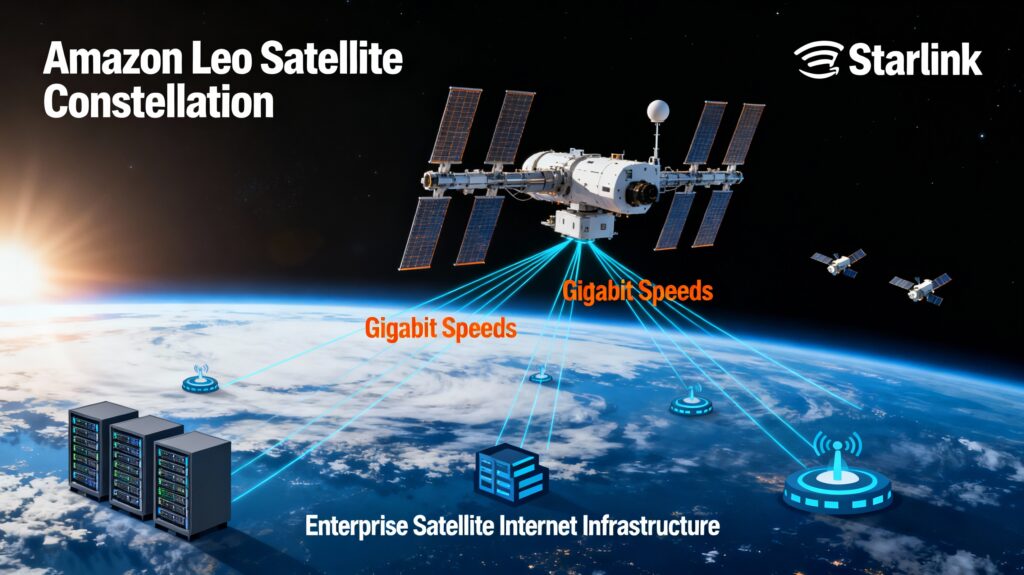
Amazon Leo’s Technical Arsenal and Business Strategy
Hardware Innovation: The Leo Ultra Terminal
Amazon’s Leo Ultra antenna represents a significant engineering leap. With a flat-panel phased-array design incorporating custom silicon, the Ultra terminal delivers:
- Download speeds up to 1 Gbps (theoretically)
- Upload speeds up to 400 Mbps (full-duplex)
- Integrated networking and encryption
- Deployment capability in harsh, remote environments
This contrasts sharply with Starlink’s consumer-grade terminals (25–250 Mbps speeds) and emphasizes Amazon’s enterprise-first positioning.
AWS Ecosystem Integration
Amazon’s decisive differentiator isn’t hardware alone—it’s cloud-plus-connectivity. Amazon Leo offers two private networking pathways:
- Direct-to-AWS (D2A): Satellite-connected devices bypass the public internet entirely, connecting directly to AWS workloads via Transit Gateway or Direct Connect Gateway.
- Private Network Interconnect: On-premise enterprise networks link securely to remote assets without exposure to the open internet.
For logistics companies tracking shipping containers across oceans, energy firms managing remote oil platforms, or maritime operators, this direct-to-cloud architecture is transformative. It eliminates the latency, security, and bandwidth bottlenecks that plague traditional satellite internet connected to public broadband.
Enterprise Preview Partners
Amazon’s beta cohort—JetBlue, Hunt Energy Company, Connected Farms, Crane Worldwide Logistics—represents verticals where reliable satellite connectivity has historically been a weak link. Each pilot generates operational feedback that feeds into a refined commercial roadmap expected to launch in 2026.
The Global Space Economy and Big Tech’s Orbital Rivalry
A Multibillion-Dollar Frontier
The global space economy reached approximately $400 billion annually, with LEO broadband identified as a primary growth engine. By 2030, satellite broadband alone could represent a $40 billion market. 5gstore
This isn’t academic projection. Starlink has already attracted over 2 million customers worldwide and partnerships with militaries, governments, and enterprises signaling adoption beyond consumer broadband. Amazon’s entry, coupled with OneWeb’s operational status and China’s nascent GuoWang constellation (13,000 planned satellites), indicates that orbital real estate is becoming a geopolitical asset.
Bezos vs. Musk: More Than a Business Rivalry
The competition between Amazon Leo and Starlink reflects deeper strategic divergences:
Starlink’s Strategy: Focus on volume—direct-to-consumer retail broadband globally, with military and government contracts (Starshield) as premium revenue streams. SpaceX owns both the launch infrastructure and satellites, maintaining vertical integration. thediplomat
Amazon Leo’s Strategy: Enterprise-first positioning, leveraging AWS’s existing customer relationships (millions of businesses globally), and avoidance of direct consumer retail cannibalization with telecom partners.
Intriguingly, Amazon uses multiple launch partners—ULA, Arianespace, Blue Origin, and even SpaceX itself—reducing dependence on any single provider while distributing risk. This pragmatic approach contrasts with Starlink’s SpaceX-exclusive launches.
India’s Connectivity Landscape and Satellite Internet Opportunity
The Digital Divide Reality
Despite Digital India’s ambitions, India’s internet penetration stands at 52.4% with 900 million users, but availability masks stark regional disparities. Fiber-optic backhaul is economically unviable in:
- Border regions (Ladakh, Arunachal Pradesh, Northeast states)
- Mountainous terrain (Himalayas, Deccan plateau)
- Island territories (Andaman & Nicobar, Lakshadweep)
- Tribal and LWE-affected zones (Chhattisgarh, Jharkhand)
In these areas, LEO satellite internet becomes not just convenient—it’s the only viable connectivity solution.
Use-Cases That Matter for India

Agricultural Advisory Systems: Farmers in remote districts receive real-time weather, soil, and market price data via satellite internet, enabling data-driven crop planning. ISRO’s Kisan portal could be amplified through satellite backhaul.
Telemedicine: Remote health camps in tribal areas can upload diagnostic imaging to specialist centers in metros, overcoming India’s acute rural physician shortage.
Distance Education: Government schools in underserved regions access quality digital content, exams, and live coaching—critical for equitable education outcomes aligned with PM e-Vidya.
Disaster Management: During cyclones, floods, or earthquakes, when terrestrial telecom fails, satellite internet provides emergency communication for rescue operations.
Maritime Security: Fishing vessels and merchant ships require continuous connectivity for safety, regulatory compliance, and anti-piracy coordination.
Integration with BharatNet
India’s BharatNet Phase II aims to connect 656,000 villages with fiber, yet satellite backhaul is already enabling connectivity to 4,952 gram panchayats where fiber remains uneconomical. A hybrid model combining fiber-optic backbone in semi-urban clusters with satellite backhaul in remote spokes could accelerate digital inclusion at lower cost than all-fiber solutions.
India’s Satellite Communication Regulatory Framework
The Spectrum Pricing Puzzle
India’s Department of Telecommunications (DoT) is charting an ambitious but contentious regulatory path. In October 2025, DoT overruled TRAI’s earlier recommendation, proposing a 5% Adjusted Gross Revenue (AGR) fee for non-GSO satellite operators (vs. TRAI’s 4% proposal), arguing that as satellite services expand to retail consumers, revenue potential justifies higher fees.
This distinction matters:
| Aspect | DoT Position | TRAI’s Original Proposal | Impact |
|---|---|---|---|
| Spectrum Fee | 5% AGR | 4% AGR | Higher operational costs for Starlink, Amazon Leo |
| Urban Customer Subsidy | Rejected | ₹500/year | DoT cited implementation challenges |
| Rationale | Revenue expansion | Incentivize rural deployment | Market access vs. affordability trade-off |
DoT’s reasoning is administratively sound—verifying rural vs. urban customer distinctions creates auditing nightmares. Yet the rejection of rural subsidies reflects a fiscal constraint versus affordability dilemma that could limit satellite internet penetration among lower-income users.
IN-SPACe Authorization and Foreign Satellite Licensing
The Indian National Space Promotion and Authorisation Centre (IN-SPACe), established in 2020, acts as India’s nodal regulator for private space activities. By March 2025, all foreign non-GSO operators (Starlink, Amazon Leo, OneWeb) must secure IN-SPACe authorization to continue services in India.
Between November 2022 and December 2024, IN-SPACe issued 38 authorizations to 23 entities, predominantly for foreign operators seeking to provision satellite capacity to Indian users. This administrative layer adds compliance overhead but ensures India maintains technical oversight of critical communications infrastructure.
Data Localization and Sovereign Control
In August 2025, India approved Starlink’s Unified License with stringent data sovereignty mandates:
✓ Earth station gateways must be established in India
✓ Zero routing of Indian user traffic abroad (no copies, mirrors, or decryption outside India)
✓ All data processing within Indian borders
✓ Compliance with lawful interception provisions
These requirements—unique in their specificity—set a precedent for Amazon Leo and other foreign operators. They reflect India’s determination to prevent a scenario where U.S. intelligence agencies access Indian user data through foreign-controlled satellites, a concern amplified by Starshield’s explicit military applications.
Strategic Autonomy vs. Big Tech Dependency
The National Security Dilemma
India faces a paradox: Satellite internet connectivity accelerates development, yet reliance on foreign-controlled mega-constellations poses geopolitical risks.
Elon Musk’s Starshield—a military satellite service using technology identical to consumer Starlink—is contractually embedded with U.S. National Reconnaissance Office and Defense Department, raising uncomfortable questions:
- Could Musk’s political alignment with the U.S. administration influence service availability to India?
- If Starlink terminals have backdoors for U.S. intelligence, are Indian military/government communications at risk?
- What leverage could U.S. foreign policy exert if India’s critical infrastructure depends on Musk-controlled systems?
India’s strategic autonomy doctrine—prioritizing national interests independent of external pressures—demands indigenous alternatives.
The Domestic Satellite Ecosystem
India has begun building counter-capabilities:
ISRO and NavIC: ISRO’s Navigation with Indian Constellation (NavIC) provides a GPS-independent positioning system with encrypted military variants, reducing dependence on U.S. GPS.
Jio Satellite Communications: Reliance Industries’ satellite venture, partnered with Airtel, is developing indigenous LEO capacity targeting enterprise and consumer segments.
OneWeb-Bharti: Bharti Airtel’s stake in OneWeb (650-satellite constellation) provides India a partial ownership claim in a major LEO system.
NSIL and Earth Observation PPP: ISRO’s commercial arm (NSIL) and a proposed public-private partnership for earth observation satellites build indigenous imagery and broadband capabilities.
Yet these efforts remain nascent and underfunded compared to SpaceX/Amazon’s billions. India’s space budget (~$1.5 billion annually) is dwarfed by SpaceX’s annual revenue alone.
Governance, Ethics, and Space Sustainability
The Space Debris Crisis
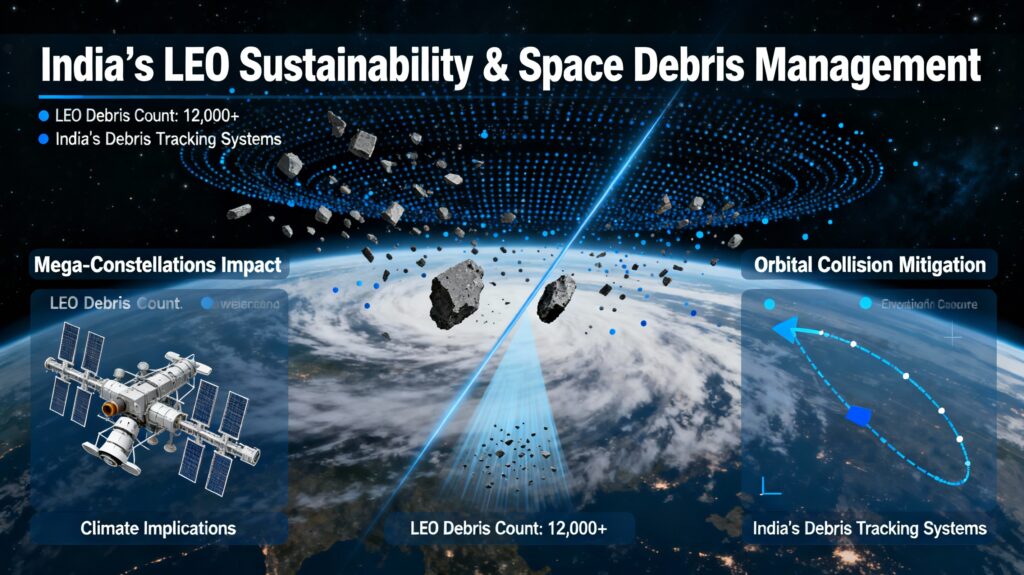
Every mega-constellation exacerbates orbital congestion. Starlink’s 6,000+ satellites create ~19,000 fragments if a single catastrophic collision occurs. Amazon’s 3,236-satellite constellation adds proportional risk.
IADC (Inter-Agency Space Debris Coordination Committee) models predict that without rigorous post-mission deorbit protocols, LEO will become increasingly unusable within 10–20 years due to cascading collisions—the “Kessler Syndrome.”
India’s Debris Mitigation Leadership
India has emerged as a space sustainability leader:
- IS4OM (ISRO System for Safe & Sustainable Operations Management): Established 2022, it monitors collision risks and performs avoidance maneuvers. In 2022, ISRO executed 21 collision avoidance maneuvers successfully.
- Debris Free Space Mission (DFSM): India declared in 2024 an intent for all Indian space actors—governmental and non-governmental—to operate debris-free satellites by 2030, adopting mandatory post-mission deorbit protocols.
- Project NETRA: Early-warning system detecting debris and hazards threatening Indian satellites.
These initiatives position India as a model for responsible constellation management—a soft power asset in multilateral space governance.
Environmental and Astronomical Concerns
Mega-constellations pose non-traditional threats:
- Orbital light pollution: Thousands of reflective satellites compromise astronomical observation, damaging scientific research.
- Atmospheric pollution: Satellite reentry produces aluminum oxide that accumulates in the upper atmosphere, potentially altering chemistry.
- Equity concerns: Rich nations’ mega-constellations monopolize valuable orbital slots, limiting access for Global South nations.
Policy implication for India: India should champion binding international norms through COPUOS (UN Committee on Peaceful Uses of Outer Space) and IADC, ensuring LEO remains a sustainable commons, not an exploited frontier.
Policy Recommendations for India
Short-Term (2025–2026)
✓ Clear Foreign LEO Licensing: Establish transparent criteria for non-GSO operators (Starlink, Amazon Leo, OneWeb) balancing market access with security vetting.
✓ Pilot Deployments in Difficult Terrain: Authorize limited satellite internet trials in Ladakh, Arunachal Pradesh, and Andaman Islands under strict monitoring and fallback terrestrial connectivity.
✓ Data Localization Enforcement: Mandate regular audits ensuring foreign operators comply with earth-gateway and zero-export requirements.
Medium-Term (2026–2030)
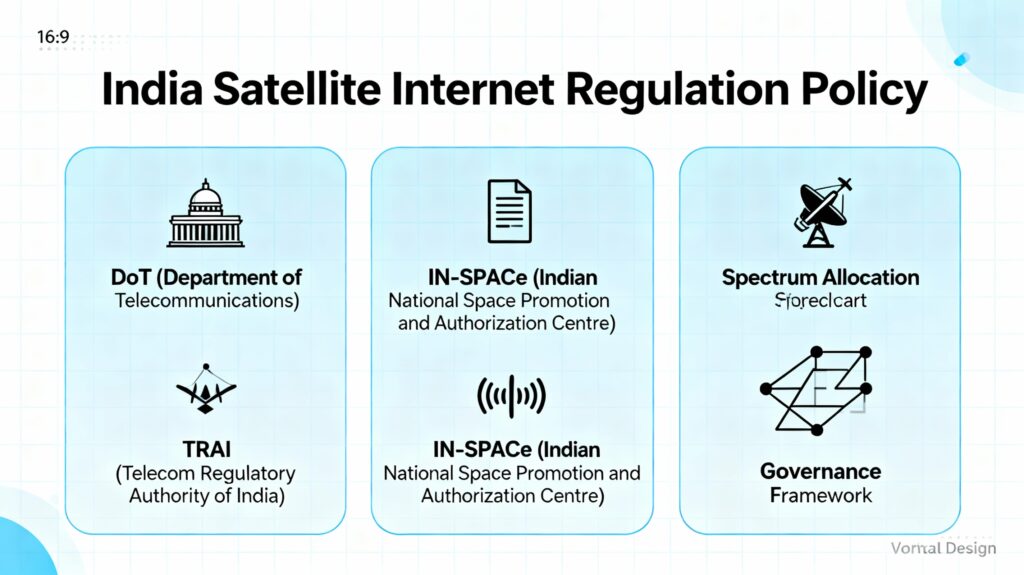
✓ Indigenous LEO Constellation R&D: Fund Jio Satellite, NSIL, and startups developing India-controlled LEO capacity. Allocate ₹2,000 crore over 5 years for constellation R&D.
✓ Hybrid Connectivity Model: Integrate satellite backhaul into BharatNet Phase III, targeting 1.5 crore rural FTTH + 5,000 satellite-enabled gram panchayats by 2028.
✓ Spectrum Efficiency Framework: Revisit 5% AGR fee; consider sliding-scale pricing incentivizing rural deployment and competition.
Long-Term (2030+)
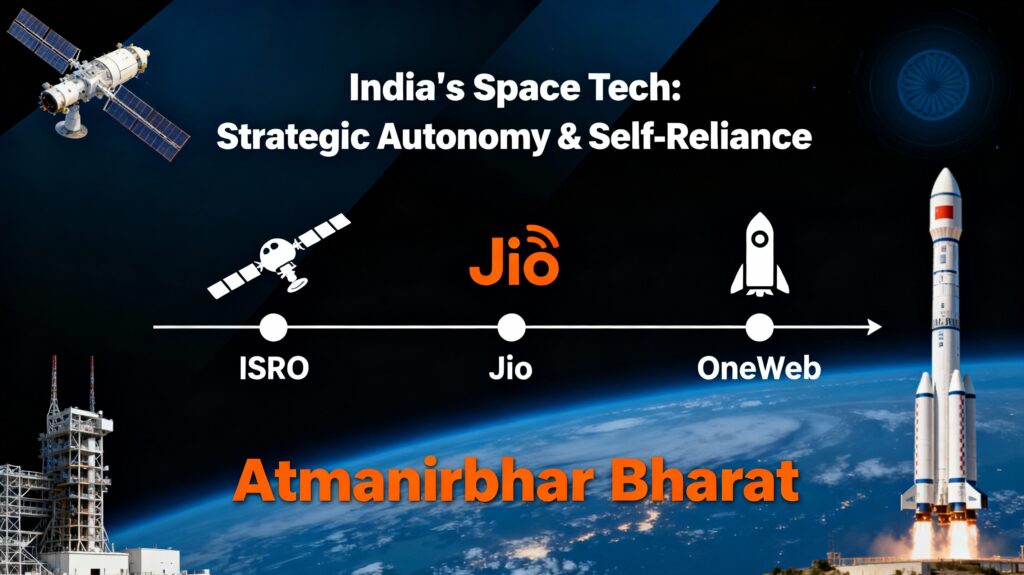
✓ Multilateral Space Diplomacy: Lead BRICS, Global South coalitions advocating for equitable orbital resource allocation and binding mega-constellation norms via ITU and COPUOS.
✓ Public-Private Partnerships: Model satellite internet + digital public infrastructure (telemedicine, e-governance, education) integration, ensuring equity and resilience.
✓ Atmanirbhar Bharat in Space: Build indigenous satellite manufacturing, custom silicon design, and ground-segment ecosystems reducing import dependence from 80% to 20% by 2035.
Conclusion
Amazon Leo’s enterprise preview marks a inflection point. For the first time, two global tech giants—Bezos and Musk—are competing directly for orbital dominance and terrestrial market share. For India, this opens unprecedented opportunities: satellite internet can finally connect 250+ million citizens in underserved regions, accelerating digital inclusion, agricultural modernization, and disaster resilience.
Yet the stakes are equally high. How India regulates foreign LEO operators, protects data sovereignty, and builds indigenous alternatives will determine whether satellite internet becomes a tool for empowerment or a vector for geopolitical leverage.
The policy choices are nuanced:
- Pragmatic openness to access transformative technology while safeguarding strategic autonomy
- Regulatory clarity that attracts investment without creating loopholes
- Investment in homegrown capabilities matching the private sector’s ambitions
- International leadership on sustainable orbital practices and equitable governance
India stands at a crossroads. The decisions made in 2025–2026 by DoT, TRAI, and IN-SPACe will reverberate for decades. The satellite internet revolution is inevitable. India’s role—leading or following—remains a choice.
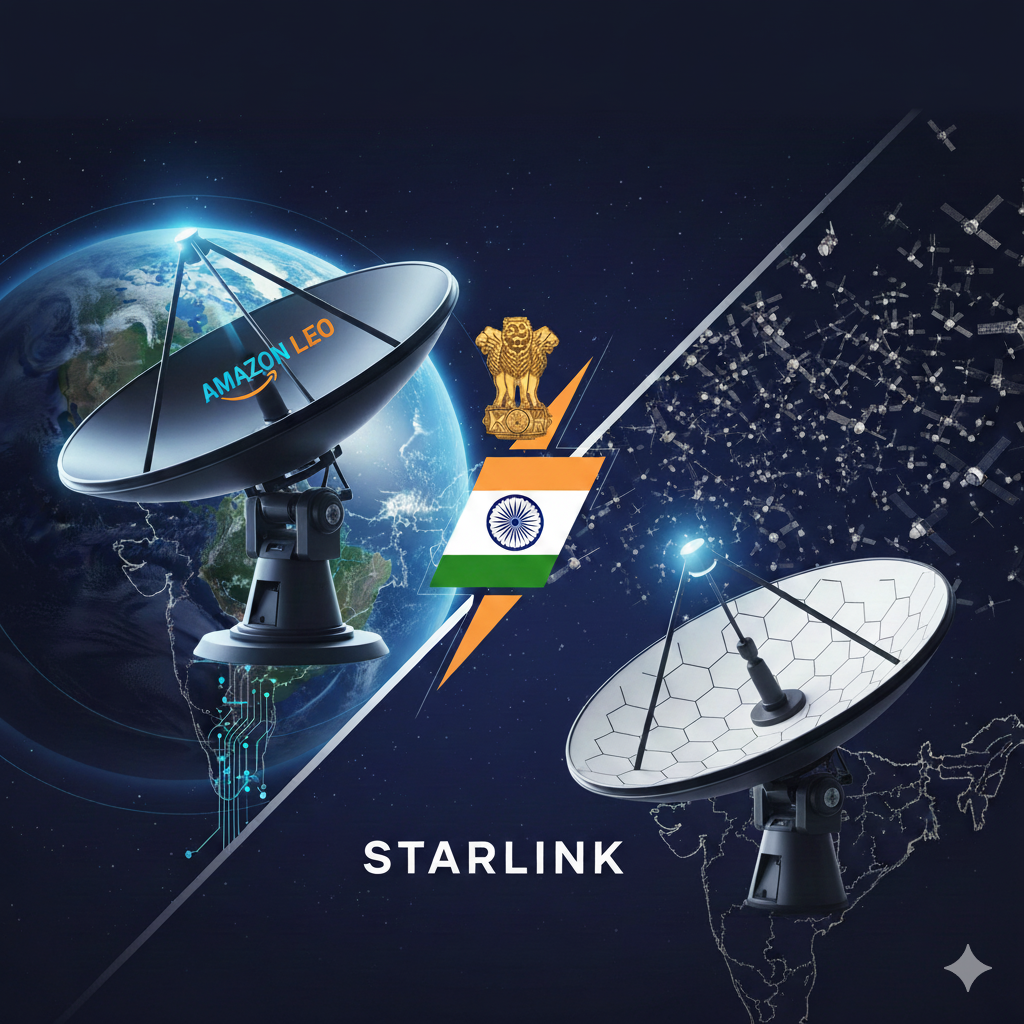
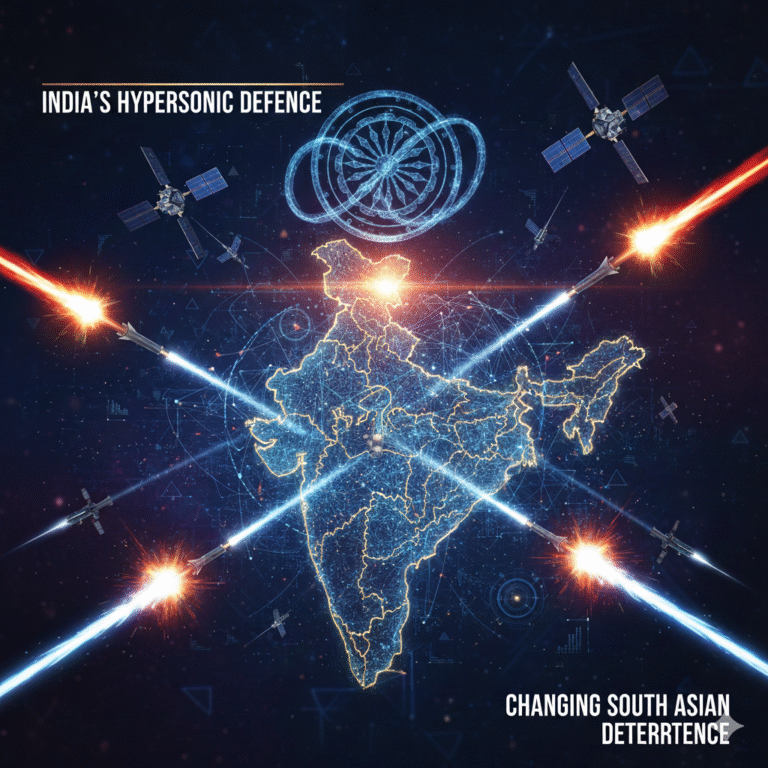
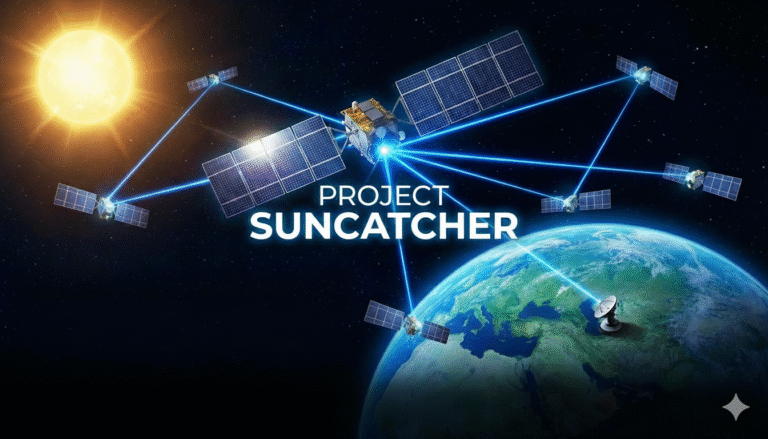
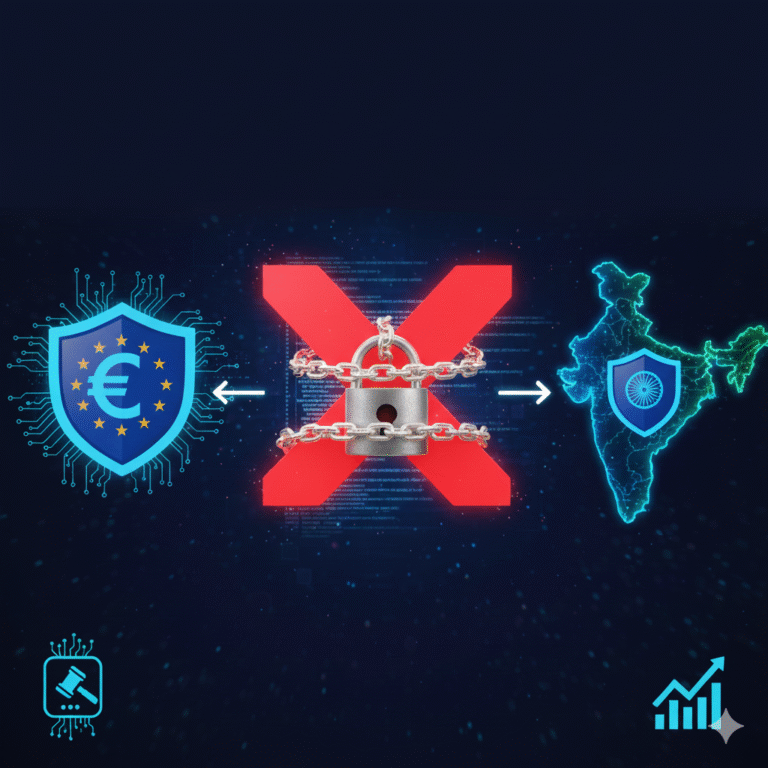



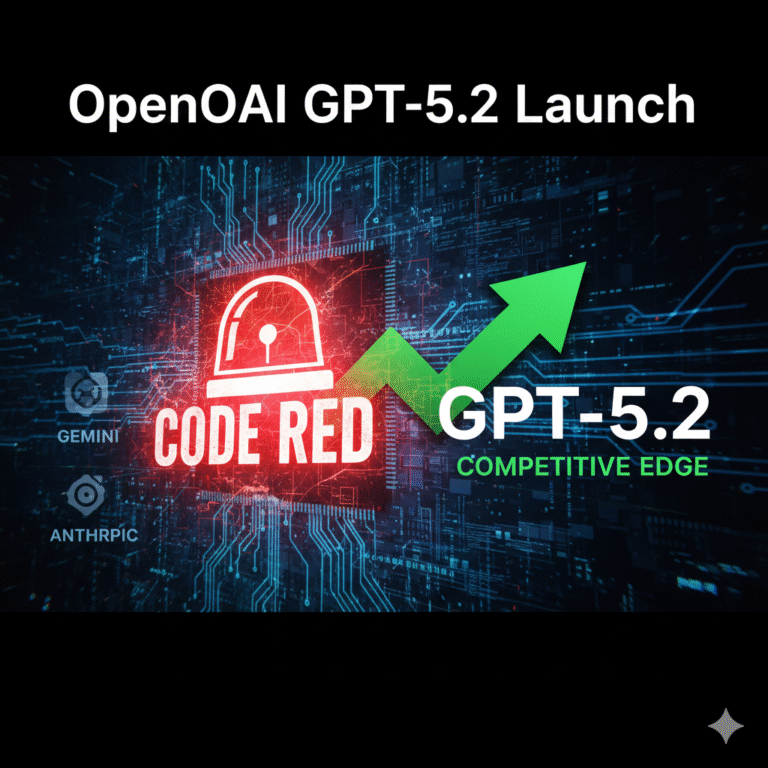
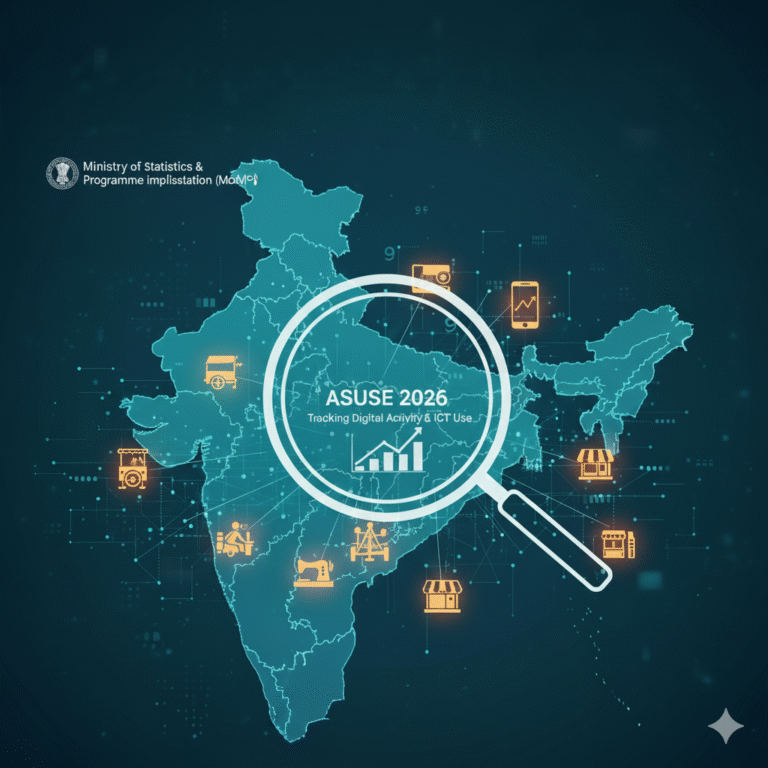
+ There are no comments
Add yours